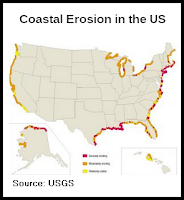Beaches are a favorite summertime destination but they are suffering from environmental degradation and climate change. Our coastal and inland beaches are facing some very serious problems due to overpopulation, obsolete sewage systems, and erosion associated with climate related sea level rise. These impacts on coastal ecosystems is documented in a 2014 report titled Coastal Zone Development and Ecosystems.
The growth of coastal populations has put a profound strain on aging infrastructure resulting in polluted beaches and waterways. Each year, more than 1.2 million people move to the coast. Beaches are suffer from erosion due to extreme weather and rising sea levels. This includes inland beaches like those along the shores of the Great Lakes.
Fresh water beaches are subject to increasing levels of salinity due sea level rise which pushes ocean water inland. The higher salt content in inland waters contribute to a feedback loop which exacerbates pollution. Salt water corrodes sewage pipes which causes leaks that can lead to high levels of water born contamination in recreational swimming areas.
The combination of water borne waste, litter and watercraft are making our beaches sick. The most recent American Society of Civil Engineers’ (ASCE) Infrastructure Report Card gives the nation’s wastewater systems a very poor grade. The report indicates that over 900 billion gallons of untreated sewage are dumped into local waterways each year. This is particularly true during storms.
Inadequate infrastructure was also singled out as the primary source of water pollution by the Natural Resource Defense Council (NRDC) in its annual Testing the Waters report.
The U.S. National Climate Assessment for the Great Lakes warns that increased precipitation wrought by climate change will continue to amplify combined sewer overflows and surface runoff, degrading regional water quality.
There are several things that can be done to address the problems faced by our beaches. Population density can be minimized along the coasts and inland waterways by issuing less building permits. Infrastructure investments can improve sewage lines and treatment. In particular these facilities can be upgraded to accommodate storm surges. Perhaps the most important single thing that can be done to save our beaches involves reducing our greenhouse gas emissions. This will can keep temperatures from rising dramatically. The result will be less sea level rise and lowered frequency of storm surges associated with extreme weather.
Related
El Niño and Global Warming are Locked in a Feedback Loop
The Dangerous Feedback Loop Between Wildfires and Climate Change
Arctic Warming Feedback Loops: Algae Blooms and Thawing Permafrost
Home
climate change
complex
conjoined
connection
Global Warming
interconnected
interrelated
related
Beaches are Facing Environmental and Climate Threats
- Blogger Comment
- Facebook Comment
Subscribe to:
Post Comments
(
Atom
)

0 comments:
Post a Comment